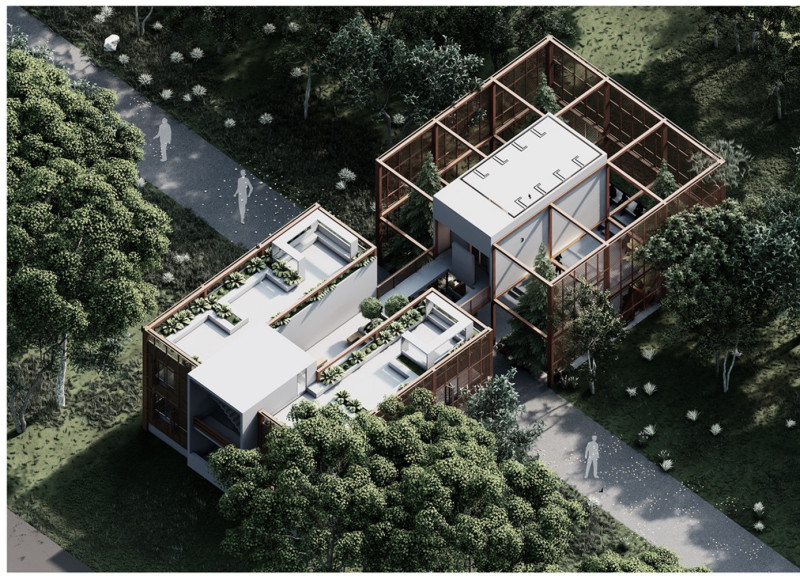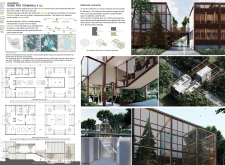5 key facts about this project
The architectural design emphasizes the integration of outdoor and indoor spaces, allowing residents to experience nature's calming influence. Surrounding the structure is a landscape that not only enhances the aesthetic value but also reinforces a therapeutic atmosphere conducive to healing. Through extensive use of glass façades, the building captures natural light and offers unobstructed views of the park, fostering a sense of openness and tranquility. This connection to nature is a fundamental element of the design, acknowledging the importance of the environment in shaping our emotional experiences.
Inside the hospice, spaces are meticulously organized to encourage social interaction while respecting individual privacy. Common areas are strategically placed to facilitate gatherings for families and friends, promoting a sense of community through shared experiences. The therapy rooms are designed to provide supportive spaces for group activities, enhancing the healing process. The layout serves a dual purpose: while it invites families to come together, it also offers private rooms where patients can find solace away from the public view, allowing them to retreat into a personal sanctuary when needed.
Unique design approaches characterize this hospice, particularly in its architectural strategy and functioning. The concept revolves around the idea of “moments,” where each section of the building encourages mindfulness and reflection. Pathways are thoughtfully laid out, featuring benches that signify points of pause—each a reminder of the significance of stillness in our fast-paced lives. This arrangement allows patients and visitors to engage actively with their surroundings, promoting interactions that can lead to meaningful conversations and connections.
The architectural approach is also notable for its careful selection of materials. The use of steel frames establishes a structural integrity that supports expansive glass panels. This choice not only reinforces the building’s modern aesthetic but also enhances natural light penetration. The incorporation of wood elements adds warmth and comfort to the interiors, while textured mesh panels throughout the structure serve to filter light and offer privacy, balancing the need for openness with the requirement for personal space.
Moreover, the project embraces a holistic view of wellness by integrating nature within and around the building. Roof gardens and planted terraces create inviting outdoor spaces that encourage residents and visitors to engage with their environment actively. These features contribute to a sustainable ecological approach, reducing heat absorption and improving the overall microclimate around the hospice.
This architectural project stands as a notable example of how thoughtful design can address complex social and emotional needs. The program and layout demonstrate an understanding of the delicate balance required in providing care for terminally ill patients, ensuring that their dignity and comfort remain paramount. Every element of the design, from spatial organization to material choices, has been meticulously planned to foster a nurturing environment where life is celebrated, even in its final stages.
For those interested in delving deeper into this innovative project, exploring the architectural plans, architectural sections, architectural designs, and architectural ideas will offer additional insights into the intricacies of its function and design features. The presentation of this hospice combines compassion with architectural integrity, showcasing a harmonious blend of form and purpose.























